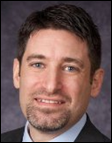HIStalk Interviews Frank Fear, VP/CIO, Memorial Healthcare
Frank Fear is VP of ancillary cervices and CIO of Memorial Healthcare of Owosso, MI.

Tell me about yourself and the health system.
I’m the vice president of ancillary services and the chief information officer at Memorial Healthcare in Owosso, Michigan. Owosso is about 20 miles from Lansing, 25 miles from Flint, and 25 miles from Saginaw. We’re a 150-bed hospital with 1,100 employees and a medical staff of about 120. Employed physician offices totaling about 15 offices and 50 providers that are sprinkled throughout about a 20-mile radius from the hospital.
Although we’re considered a community hospital, we have a lot of competition with hospitals in Lansing, Saginaw, and Flint. We’ve leveraged technology as a differentiator for us. Utilizing IT to approve efficiency, quality, safety, and frankly, trying to attract doctors. It’s very competitive for not only patients, but also attracting good doctors. I think we’ve been really successful. We’re very proud of our ability to recruit physicians. We haven’t had a lot of challenges there.
I really enjoy working here. We’re a size where we have some resources to get things done, but we’re not so big that it takes time to get things done. There’s not a lot of bureaucracy. It’s a lot of fun to work with our executive team and board. They see IT as a strategic asset and not an expense. The ability to go right to the exec team and the board and say, hey, I want to do this new, next idea that I think will have a positive impact, work with them. Apple Health integration is an example of that.
How will you use Apple Health integration?
We’ve had a patient portal for a while and we’ve attested for Meaningful Use Stage 2 in the hospital. As we all know, patient portal is one of those requirements. We’ve seen some mild success there, but it’s one of those things where we’re asking the patient many times to go out and access that. It’s almost passive patient engagement. We’re putting your data out there it’s available for you to better manage your care and and be more informed as a patient. But we’re really looking for the patient to go out and get that data.
We’re trying to figure out, how can we be more actively engaged with our patients? I like to think that there was some like grand, great vision that goes into this stuff. [laughs] I started thinking about and working with Frank Fortner, president of Iatric Systems, and said, you know, we’re always looking down at our phones. It’s almost embedded in our work flows now that you look at your smartphone. People are using Fitbits and they’re using different apps on their phone. Is there a way that, instead of us building an app or developing something and asking the patient to go look at it like we build a portal, can we somehow engage patients actively and leverage what they’re already doing and making it a richer experience?
We’re in the beginning phases of it. There’s no fully developed product or anything. I don’t want to give any misconception there.
Ever since I upgraded my iPhone to the 6, I pull up how many steps have I had today and say, I have to put a few more thousand steps in to keep myself at that average. How can Memorial Healthcare get in that workflow and enrich that experience for the patient?
The doctor can’t really do much with step counter information. Do you see the Apple Health-powered patient engagement going beyond that?
That’s our vision. [laughs] If a patient’s looking at that app on a regular basis to do steps, could we push vital signs to it? Could we push blood pressure to it? Diabetes is such an epidemic in our country. Could we push blood sugars to it and not ask the patient have to type that in? We’ve already captured some of that information at their office visit. Could we enrich that Apple Health application to make it more valuable for the patient and connect them or tie them back to their care provider?
That’s how we’re envisioning Apple Health. Enriching that app so it’s more useful for the patient.
We look at Apple Health as just a starting point. We want to leverage that the tool that we’re developing with Iatric to push data to the next app. Let the patient choose what apps that they’re going to want to utilize. Apple Health, we thought, was a natural starting point. It’s already on the phone. You don’t have to install it. Apple’s done such a good job with usability.
Whatever comes next, we have this integration tool that would push data to these apps to make them more useful, more valuable. That’s our vision. We want to push data that we think that will make that application more usable, more valuable for them. If they’re already actively looking at it, we’ve somehow dealt with that hurdle of getting people to utilize it. They’re seeing some value there at some level. How can we extend that?
When you look at your IT capital budget over the next few years, where will you be making investments?
Next year we’ll be focused a lot more on real-time analytics to improve quality at the point of care. We’ve got dollars budgeted to look at data in real time as patients are in the hospital or an office visit to say, we know you have an office visit. We know you have certain chronic conditions. We see that there are certain labs being done, certain meds. Start prompting providers to query the patient or suggest something that they need to order.
On the hospital side, with Core Measures, value-based purchasing, clinical quality metrics, it’s looking at the data and then suggesting actions to providers. Starting to alert them as the discharge comes near. Or some sort of time parameter … certain antibiotics need to be given so many hours before a surgery. We start suggesting.
We’ve built a lot of that stuff into order sets, but now we want something that’s a little more dynamic that is notifying a nurse or notifying a doctor. Sepsis is a big focus for us. Having some automated tools that start looking at different data elements and notifying the nurse of potential sepsis and then notifying a physician as it escalates that they take certain actions.
For us, the analytics is going to be more of a real-time nature. We’re already doing some stuff with population health and tools there that look at a population and look at risk stratification, identifying higher risk patients and engaging them. We’re doing some stuff there already. I don’t know if we’ll continue that investment, but when you talk about net new, it’s going to be more of that real-time actively engaging patients based on data that we already have in our systems.
You’re feeling good about your Meditech and Allscripts systems?
We’re on Meditech Magic. It’s a tool that we’ve had for going on 21 years at Memorial. We know we’re going to need to do something with it. But we’re spending quite a bit of time trying to understand what value will be created and what business problem will be solved by upgrading our Meditech Magic system to the latest and greatest Meditech platform or another platform.
It’s a significant capital expense, but it’s also a significant resource drain on the entire organization. It pulls us away from other projects that we could be doing that are non-IT related. We’re spending a lot of time understanding the value proposition for us before we decide to go down that road.
Meditech has not announced the end of life of Magic. There’s been some recent announcements I think that actually extend the life of our Meditech Magic system. We’re trying to leverage third-party systems to do some of the analytics that our Meditech system is challenged with since it’s a 20-plus year platform for us.
Which health system priorities and challenges will have the most impact on IT?
There’s a laser focus from our board all the way down to the frontline staff on clinical quality. It’s critically important that we provide the safest care, highest quality care, and frankly, the most efficient care that we can provide. We’ve hired a vice president that’s focused on process improvement and efficiency. We’re seeing cuts in reimbursement. We’re heavy Medicaid and Medicare in our region, so we need to figure out a way to be able to be sustained on that Medicare or Medicaid type of reimbursement. There’s a real focus there.
There’s a definite role that IT plays there and can play a big part. We have played a big part up to this point, but we need to elevate our game to another level and try and move away from so much implementation mode and spend a lot more time in optimization. Then when we are in implementation mode, that it’s clear to us that there’s going to be an impact to an outcome measure that’s going to improve quality and efficiency. We’re going to play a big role there.
Employee engagement, physician engagement, and leadership development are three key strategies for us. They all center around people and engaging people. These systems that we’ve implemented directly impact our day-to-day physician workflows, directly impact our employee workflows. Really, truly engaging those folks to understand how we can improve those tools and improve their quality of life at work.
Not have the tools be an annoyance factor, to be something that enriches their work and they feel strongly about it. I’m not suggesting that they don’t feel that way, but there’s more work we can do there to ensure that we’re enriching the patient experience and not causing frustration.
When a physician is frustrated and struggling using a system, it impacts their overall engagement. It impacts their satisfaction and ultimately impacts how they deliver care. Spending a lot of time with our physicians and staff and engaging them and improving and optimizing these tools. Making sure that we truly hear their concerns, respect them, and are sensitive to them. That doesn’t mean we can fix everything or make every change they request, but a two-way engagement where they’re bought in and they understand the limitations.
What should vendors know about your job and your challenges as a CIO that perhaps they don’t?
For our vendors, as much as I have a love-hate relationship with them, they’re critical to my success and the organizational success. If our systems don’t perform well and work well, it’s very difficult for an organization to be successful. It’s just the reality of it. They have a huge responsibility for being just good for basic things — good support, attentive.
I know they’ve been tremendously pressured with Meaningful Use to deliver applications in such a short turnaround time. But it’s critical, beyond just being responsive and providing good customer service, that in that partnership that truly is a strategic partnership, that they spend some time understanding not just Meaningful Use, but what some of the key drivers or key focus areas that the executive team is focused on and that our board is focused on. Then working with us to try and develop applications or optimize applications to try and move whatever outcome measure that we’re focused on, that our board is focused on, our community is focused on. That takes time.
We’ve had a wonderful relationship with Iatric and I think this is an example. Frank will come up and sit down with me and we’ll have conversations about what are the main things that you’re focusing on right now. We’ve built tools in the past with them to address our strategic priorities. That’s so important, that they stay in touch and in tune with what’s going on with our organization and providing solutions that will address some of those challenges.
Easier said than done. I know they’re under tremendous pressure to deliver regulatory compliance functionality, but if we focus just purely on the regulatory stuff, we’re not going to be successful. We need to be able to make sure that we’re addressing some of the strategic priorities that go well beyond Meaningful Use and ICD-10. That’s so tough with limited resources, but we have to find ways to address that stuff. That’s what this Apple Health thing is that we’re trying to do. Actively engage our patients to keep them connected to organization to improve quality and better care.
Do you have any final thoughts?
Behind the Apple Health piece, we’re spending a concerted amount of effort on the security side of the tool. Part of this implementation is going to be educating our patients on what it means to use a tool like Apple Health or any other application where they’re sharing their health data and what that will mean and implications for that. It’s tremendously powerful tools, but we’ve got to make sure that our patients understand some of the potential risks with pushing that data to a centralized repository.
We’re developing goals for the project right now with Iatric and ensuring that the application that we’re going to leverage to push data to Apple Health that is SSL encrypted, that data isn’t stored on the actual device. Of course, once it gets pushed to Apple Health, it’s going to be stored at some level on the device, but making sure that the rigor is done there to educate patients on the risk and then do everything in our power to secure the application and ensure that the transmission process and the review of the data process is done securely.
Another piece that I feel very strongly about as we go down this Apple Health path is that data isn’t necessarily just automatically pushed. A patient is notified that, hey, there’s new data available, evaluate it and determine whether you would like this data in Apple Health. Having the patient be more actively engaged in making decisions about the data that they own. Having it notify them goes beyond that passive engagement where they have to go out to a patient portal. There’s new data there.
They may not even be sometimes be aware of it. You go to the physician office, they take your vitals, your blood pressure. Sometimes the doctor may not share the vital information or they may not share all that information with you. This is notifying the patient, here’s your data, take a look at it, and you may decide to push it to Apple Health or whatever app. Having them be more involved in the process and not just having it all push to different tools and not understanding those risks.
Great concern and care is being placed on the sensitivity of this data and the security of it. It’s really important as anybody explores some of these commercially available tools.


















Traditionally Professional Courtesy is something that physicians gave each other - but we had to be careful with it when…